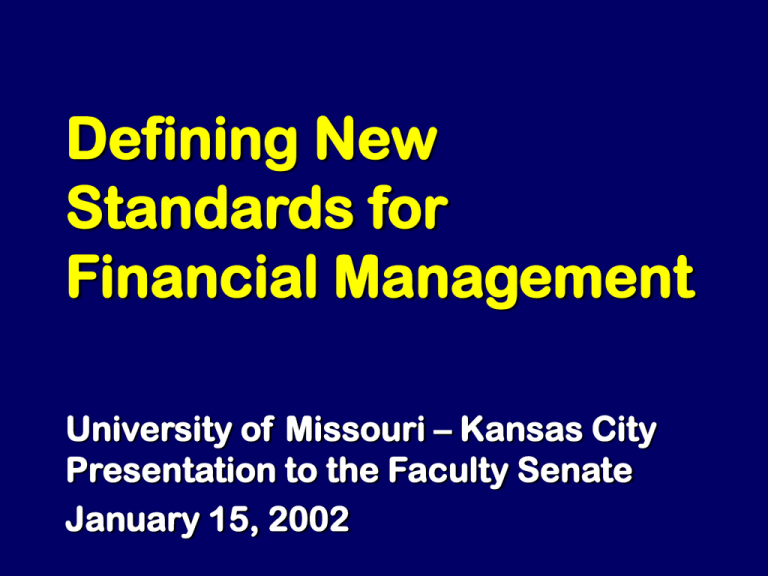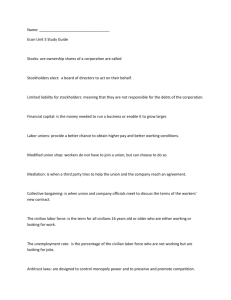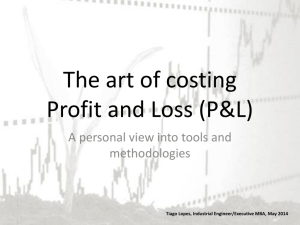Defining New Standards for Financial Management University of Missouri – Kansas City
advertisement

Defining New Standards for Financial Management University of Missouri – Kansas City Presentation to the Faculty Senate January 15, 2002 Future Budget Picture at UMKC Year 1 Year 2 Year 3 Year 4 Year 5 2001 - 2002 2002 - 2003 2003 - 2004 2004 - 2005 2005 - 2006 Financial Understanding Financial Viability Financial Freedom 2 Reality Recession - Serious cuts in public higher education in 44 States Missouri tax structure Change in the way we are handling financial management Items remain as cost funded centrally without a permanent (rate) revenue source 3 “The true test of leadership is the capacity to tell the hard truths” Jeff Bezos 4 “People are always blaming their circumstances for what they are. I don’t believe in circumstances. The people who get on in this world are the people who get up and look for the circumstances they want, and if they can’t find them, make them.” George Bernard Shaw 5 This is Us & We Are the LEADERS 6 The Facts: Ending Cash Balance Requirement: Curators require a minimum of a 5% cash balance at the end of the year (FY 2002 Budget - $8.4 million) Our Goal is to have an ending cash balance of at least 6.0% of our annual revenues or $10.0 million 7 The Facts: Current Budget Constraints Original Budget was based on only 97% of the approved State Appropriation of monies Added Revenue Cuts - $5.12 million o July 2001 - $3.5 million (5.0% withholding) o January 2002 - $1.65 million loss in state appropriation which now requires added reallocations 8 The Facts: Unfunded Commitments & Requests FY 2002 Budget included a centrally held reserve of $8.7 million to fund various “known” program commitments – YTD tallying of these off-budgeted items totals over $14.6 million As a result, there are $8.64 million in program commitments do not have current permanent revenues to cover expenses – Need for Reallocation 9 The Facts: “Some” Good News Estimated $2.0 million growth in budget revenues in Education Fees from what was originally projected Centrally budgeted contingency reserve has a balance of $2.94 million 10 The Facts: Recap Mid- Year Budget: + $ 2.00 million + $ 2.94 million - $ (8.64) million - $ (1.65) million - $ (2.26) million Education fees Central reserve Unfunded program commitments Mid-year withholding Shortfall in ending cash balance target _______________ Total $ (7.61) million Reallocations or reductions needed11 The Facts: Looking at FY 2003 Budget : Additional 5.0% cut in State funding which means $4.3 million in less revenues Probable increase of 8.0% in Education Fees or $5.6 million in added revenues More than $8.0 million in new and added department program spending requests and initiatives 12 UMKC TOTAL ANNUAL BUDGET ALL FUNDS REVISED 2002 BUDGET $239,238,866 Total FY 2002 Revenues All Funds - $239,238,866 Restricted $45.6 million 19% Designated $21.7 million 9% General Operating Fund Revenues $168,821,365 Operating $168.8 million 72% State $81.4 million 48% Fees - $77.2 million 46% Other - $10.2 6% 13 The Opportunity: Lead as Defining New Standards Say what is so out loud (integrity and candidness) Collaborate Stick with the values Support each other 14 The Opportunity: Lead as Defining New Standards • We are campus leaders • Encourage your colleagues to participate – – Campus meetings – Unit meetings • Be constructive • Think creatively • Remember UMKC’s vision and values 15 The Opportunity: Lead as Defining New Standards Great leadership because we dealt with the circumstances, not because we got the circumstances we wanted. Great leadership because we created the future we wanted in our vision- we did not go into survival and move to mediocrity 16 Looking Back 3 Months from Now – What is Possible? • We did not lose sight of our values in the face of adversity • We stuck with our vision in the face of adversity • We collaborated to find solutions • The organization will emerge stronger • The predictable (turf and “hunkering down”) did not happen • We engaged the collective wisdom effectively • We reallocated the $7.6 million and we see more opportunities for the future 17 Next Steps: Budget Planning: o We need to ask ourselves: • What options are available for short and long term budget efficiencies? • What options are available for revenue enhancements? • What options available to save money? 18 Next Steps: Budget Planning: Gain a better understanding of our budgets – Budget staff committed to meet with each of us to gain a better understand the issues facing each of our units Questions we need to think about: 1. What revenue sources do you have available beyond the general operating budget? 2. How do your expenditures year-to-date compare with the original budget projections 19 Next Steps: Budget Planning: oWe need to engage ourselves in owning the issue and the solutions oNeed for other meetings and faculty involvement? 20 Design of Collaborative Process Four Guiding Principal A. Stick with the vision and values (these came from the grassroots of this organization) B. Avoid "silo only" conversing which often leads to entrenchment and a set up for failure C. Executive Cabinet places high value on unit level Authority and Responsibility D. Take a Five Year Perspective – We need to strategically realign our priorities within the availability of funds 21 Defining New Standards for Financial Management University of Missouri – Kansas City Presentation to the Faculty Senate January 15, 2002



